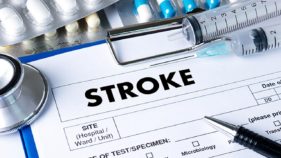
Stroke is one of the many debilitating diseases in today’s society and a leading cause of death and disability worldwide with a prevalence of 1.14 per 1000.
A stroke happens when a major blood vessel (artery), which supplies nourishment and oxygen to the brain ruptures or is suddenly blocked. Disrupting this vital supply line to one-half of the brain results in paralysis on the opposite side of the body. Stroke is often preventable, but in low and middle-income countries such as Nigeria, where the primary care services are often limited, the burden of stroke mortality is high.
According to the world stroke organisation (WSO), 90 per cent of strokes are associated with 10 risk factors that can easily be identified: hypertension, exercise, diet, weight, smoking, alcohol, cholesterol, diabetes, depression and stress, and atrial fibrillation (AF, or AFib).
Stroke prevention
Stroke can be prevented in many ways across all boards, from government and policymakers to healthcare professionals to members of the community. Ways to prevent stroke include:
• Increasing awareness
Despite being the second biggest killer globally, awareness of stroke risk factors and how to manage them is still relatively low. Coordinated global and national campaigns that raise awareness of how to reduce and manage individual stroke risks have the potential to deliver significant gains in stroke prevention.
• Discovering risk factors for stroke and managing them appropriately
• Implementing population-wide preventive strategies
Despite clear evidence of the effectiveness of population-wide strategies, there is still not a single country in the world that has implemented these in full on a population level.
• Build partnerships and advocacy
To create a lasting impact on stroke prevention, we need to build partnerships between healthcare, and government and provide the evidence to support stronger advocacy from Non-Governmental Organisations (NGOs).
• Modification of lifestyle promotion and maintenance of healthier lifestyle and blood pressure control can significantly reduce the incidence of stroke in the society. A healthy lifestyle includes not smoking (and smoking cessation for smokers), no binge drinking, being physically active, and a healthy diet characterised by adequate fruit and vegetable intake, reduced dietary trans-fat intake, and reduced sodium intake.
Stroke care international (SCI), a charity-based stroke support organisation working to beat stroke in the UK and Africa aims to prevent avoidable strokes, promote, recovery, and support life after stroke.
Mission includes:
• Stroke awareness and campaign actions: This encompasses all approaches that are concerned with screening, raising awareness, health education on risk factors, ways to reduce disease risks, and other health promotion activities.
• Health and lifestyle educational programmes that focus on risk reduction. This helps people to understand the link between high blood pressure and stroke, as well as their other stroke risk factors through organising health outreaches and stroke education to a various media stations in Nigeria.
• Stroke support services aimed at supporting stroke survivors, family, and carers on their journey to live the best possible life after stroke by creating a positive environment to meet other stroke survivors and share experiences.
• Research, developing, and delivering education and training for healthcare professionals.
Stroke rehabilitation
Stroke survivors live with long-term consequences such as disabilities and often manage their resulting limitations and health status as a chronic condition.
• Ekeng is a Stroke Nurse Consultant and executive board member of the World Stroke Organisation (WSO)
As the population of stroke survivors increases and the number of survivors with a disability and chronic care needs grow, rehabilitation care and therapy play an increasingly important role in integrating survivors back to society.
Rehabilitation is an important part of recovery after a stroke that helps patients relearn skills that were lost, regain independence, and improve the quality of their lives. Stroke affects each person in different ways and survivors may experience a range of physical limitations such as paralysis of one side of the body, difficulty with language and speech, difficulty swallowing, vision problems, and imbalance.
Stroke rehabilitation may include physical, occupational, speech, and recreation therapies.
Physical therapy: Physiotherapy is an integral component of recovery from a stroke as it will improve health and independence. It uses specialised modalities and exercises to help survivors relearn movement and coordination skills they may have lost because of the Stroke.
Goals of physiotherapy involve: restoring mobility, managing motor deficits, prevent and treat complications, community reintegration, improve independence, maximise function, and coordinate continuity of care.
Occupational therapy: Focuses on restoring the ability to perform routine daily activities, such as eating, drinking, dressing, bathing, reading, and writing.
Speech therapy or cognitive rehabilitation: Speech therapy helps people who have problems producing or understanding speech.
• Ekeng is a Stroke Nurse Consultant and executive board member of the World Stroke Organisation (WSO)


Be the first to comment